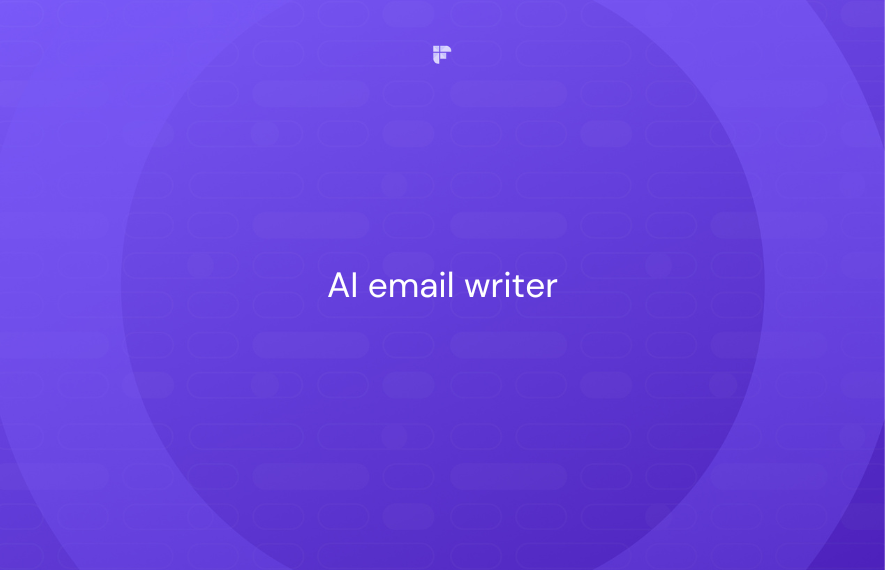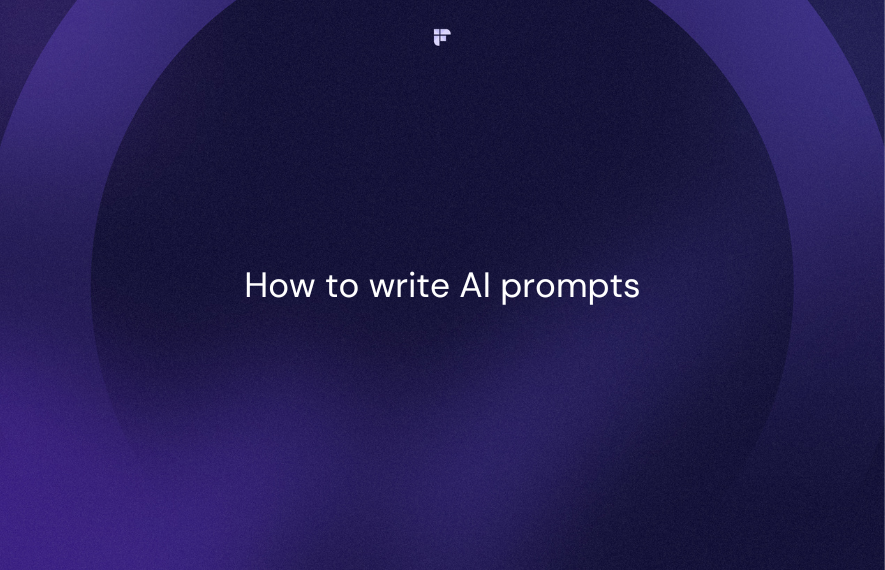Ever wondered how people get AI to write poems, translate languages, or even design graphics? It all starts with writing effective AI prompts.
In this guide, we will explore how to write effective AI prompts, breaking down key elements with tips and examples.
Let's start by understanding what an AI prompt is.
Related: How to Use ChatGPT to Boost Your Sales Productivity: Use Cases & Prompts
What is an AI prompt?
Simply put, a prompt is a text you feed into an AI model to start a specific task or output.
Prompts can be as short as a few words or longer, detailed passages packed with context and specifications.
The scope is remarkably broad, too. These prompts can generate text, code, images, data insights, videos, and more, depending on your AI model's capabilities.
A good AI prompt contains:
- What you want the AI to do (the goal)
- Context about the situation
- Examples of ideal outcomes
- Any restrictions to abide by (if any)
Why does mastering AI prompt writing matter?
Well-crafted prompts can help you generate high-quality content, streamline your workflow, and discover new ideas and insights.
By understanding how to write clear, specific, and contextually rich prompts, you can better leverage AI tools for various applications, from content creation and brainstorming to problem-solving and research.
Also, as AI technology continues to advance, the ability to write effective prompts has become an increasingly valuable skill.
How to write AI prompts: 8 Tips
Here are 8 tips to level up your prompt writing game:
1. Know your model
Not all AI models are created equal. Some excel at language tasks, some at image generation, and others at videos or coding. Knowing your model's strengths and limitations is crucial to crafting appropriate prompts.
For example, ChatGPT and Gemini specialize in natural language tasks, while DALL.E excels at generating images. Similarly, GitHub Copilot is tailored for code generation and assistance, and Sora is for videos.
Spend time learning the AI model’s capabilities. Understand how it was trained and optimized. This knowledge allows you to tailor prompts that target the model's sweet spot.
2. Get specific
Vague prompts lead to underwhelming results. If you ask ChatGPT to "write a blog post about X," you'll likely get a generic, one-size-fits-all piece.
The more specific details and constraints you can mention, the better. This will ensure the output aligns perfectly with your specific requirements.
For example, let's say you want a blog post about using AI prompts for marketing purposes. Instead of that vague initial prompt, you'd be better off with something like:
"Write an 800-word blog post aimed at digital marketers on 'Using AI prompts for better copywriting.' Include tips, examples of prompts for copy tasks, and information on why using prompts improves outcomes. Use a conversational tone."
This prompt provides:
- Word count
- Target audience
- Specific topics and angles to cover
- Desired content type (tips/examples)
- Tone instructions
3. Give references
Rather than directly instructing the AI model to perform a task, provide some examples.
Don't just tell an image generator like DALL.E to "create an abstract painting.” Show it what you mean with examples:
"Generate an abstract painting in Wassily Kandinsky’s style, featuring geometric shapes and bold colors like this: [include reference images]."
For language models like Gemini and ChatGPT, you can provide a sample paragraph and say, "Continue and expand this text in a similarly engaging, conversational tone."
4. Give your prompt a structure if needed
When dealing with complex tasks or multi-step processes, the format and structure of your prompts can significantly impact the quality of the outputs. A rambling wall of text can make it difficult for language models and other AI systems to understand it accurately.
Organize your prompts in a clear, logical way that makes it easy for the AI model to comprehend your instructions and any supplementary information. Proper structuring helps eliminate ambiguity and ensures the key elements of your prompt don't get lost or misinterpreted.
Here’s an example of a well-structured AI prompt:
Key features:
- Eliminates writer's block by generating content ideas
- Expands outlines and briefs into long-form content
- Customizable tone, style, and language settings
Target audience: Marketers, writers, content creators, agencies
Desired tone: Enthusiastic, persuasive, addressing the reader's pain points
Opening paragraph (example):
Never stare at a blinking cursor again. [Product Name] is the AI writing assistant that takes the headache out of content creation…
5. Keep refining your AI prompt
Writing the perfect AI prompt on the first shot is rare. So, don't be discouraged. Instead, use the AI's output as a starting point to refine the prompt further.
Analyze where the output succeeded and fell short, then update your prompt accordingly to steer the AI in a better direction.
For example, if an AI image lacks the desired colors, you can add to the prompt: "This time, include more muted color shades of green, matte red, and black.”
Or let's say you prompt ChatGPT to write a blog post on personal budgeting tips, but the tone comes across as too dry and academic. You could then refine the prompt:
"Thanks for the post! This time, rewrite it in a more casual, conversational tone—like you're giving friendly advice to a friend. Use more contractions and personal anecdotes/examples."
Or with GitHub Copilot, if the initial code misses some key functionality, you can refine it like this:
"Looks good, but it still needs error handling and input validation. Update the code to include that."
With 2-3 iterations, you can go from a rough initial output to a finely-tuned final result that captures all the nuances and particulars you want.
6. Ask for what you want
It seems obvious, but many get tripped up by not explicitly stating their desired output in the AI prompt. Simply asking for it can work wonders.
For example, don't just give a blog outline and hope it writes the post well. Explicitly prompt: "Use the outline to write a full 1000-word blog post."
Clearly stating the deliverable prevents confusion and ensures you get exactly what you requested.
7. Provide rich context
While modern AI language models are incredibly capable and knowledgeable, they still require sufficient context to understand your specific intent. Without adequate context, you'll likely get generic or misaligned outputs.
Think of it this way: You wouldn't ask a human writer to craft marketing email copy without briefing them on the product, target customers, brand voice, and campaign goals first. AI models need that same level of contextual grounding to produce truly resonant, tailored work.
Providing full context upfront is critical for tasks like marketing copy, ad campaigns, website messaging, and more. Don't just tell the AI to "write social media promo posts.” Give it the full background:
- Details on the product/service being marketed
- Core value proposition and key selling points
- Target audience demographics and psychographics
- Desired tone and brand voice guidelines
- Campaign themes, messages, and creative examples
- Any other strategic information that you want in the output
You can extend this contextual mindset to other use cases, too. For example, if you want an AI to assist with coding or software development, preface your AI prompts with the following:
- The core functionality and requirements
- Target programming language and framework
- Integrations with existing systems/APIs
- Performance constraints or benchmarks
- Documentation, style guides, or conventions to follow
While providing thorough context requires more upfront effort in prompt crafting, it leads to exponentially better results.
8. Experiment with your prompts
Once you've mastered the basics of clear and effective AI prompt writing, it's time to start thinking outside the box. Don't be afraid to get creative and experimental.
One such technique is prompt chaining. Instead of using one-off prompts, you can feed an AI model a series of successive prompts, each building upon the output of the previous response.
Here’s an example of a prompt chaining experiment:
Let's say you want to write a fun, engaging children's book but struggle with the initial concept and plot. To develop the story idea, you could use prompt chaining with a language model like ChatGPT or Gemini.
- Initial prompt: "Generate a unique plotline and characters for a children's picture book about a young child going on a magical adventure."
- Take the AI's output synopsis and prompt it to expand: "Thanks, that's a great starting point! Now, taking that basic plotline, flesh it out into a more detailed 300-word book summary hitting the major story beats."
- With the summary, you could then prompt concept artwork: "Using the book summary as a guide, generate 3-4 visual concepts for what key scenes from the book could look like as illustrations."
- Finally, have the AI begin scripting chapters: "Taking the updated book summary as an outline, I'd like you to start writing out the first 1-2 chapters of the children's book itself in a suitable narrative style."
What began as a vague story idea has become a much more fleshed-out vision for a children’s book. It has a plot, characters, visuals, and an initial manuscript taking shape.
Use AI prompts to mine gold from your meetings: Fireflies.ai
That's where Fireflies.ai transforms your meetings from a huge timesink to a goldmine of valuable action items and insights.
Fireflies.ai is an AI notetaker that can record, transcribe, summarize, and analyze all your online and offline conversations.
It extracts every important detail from your meetings into comprehensive Super Summaries. And with AI prompts, you can customize your meeting summaries to extract only the information you need.
Here’s how:
Step 1: Log in to the Fireflies app and go to Apps.
Step 2: Under AI Apps, click Configure for any summary section.
Step 3: Write a fresh AI prompt describing how you want to modify that summary section and click Save.
Now, Fireflies will automatically extract and summarize only the relevant information from your meetings based on your customized prompt.
Fireflies also offers a Prompt Library for various meetings and use cases, such as sales calls, interview screening, daily standup, and project management.
Learn more about customizing Fireflies Super Summaries.
Additionally, Fireflies.ai’s GPT-4 powered chatbot AskFred lets you ask questions and get insights about key details and outcomes from your meetings or uploaded media files. It can also draft relevant content like follow-up emails, blogs, and social media posts.
Here’s how you can access AskFred:
Step 1: Log in to your Fireflies account and open the desired meeting transcript.
Step 2: Click the AskFred button.
Step 3: Write an AI prompt or use the suggested prompts to ask your question.
That’s it! Fred will generate the answers in a conversational way. You can continue the conversation with new or follow-up questions.

Master the prompt, master the AI
There you have it, folks! A comprehensive guide for writing AI prompts that transform AI models from valuable resources into indispensable co-creators.
While it does take some practice, prompting is an incredibly empowering skill. As you refine your skills, don't forget to explore AI prompt generators, which can help streamline the process and inspire your prompts.
With these tips, you're well on your way to becoming a bonafide AI prompt pro.









